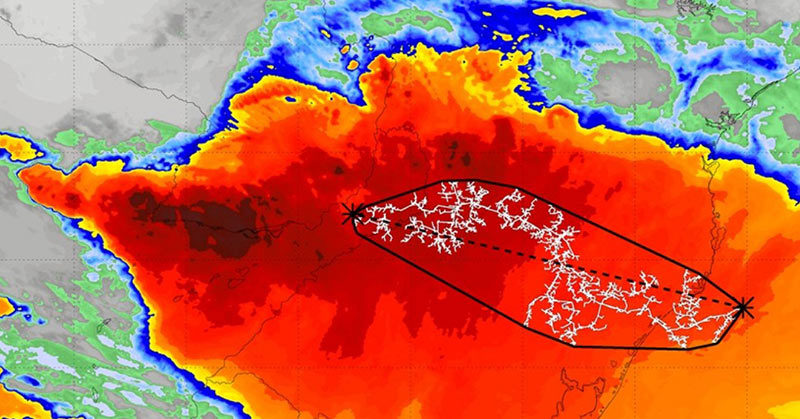Lightning is extraordinary, beautiful, and awe-inspiring to see. It can also be incredibly scary, particularly if you’ve ever had a close encounter with these potentially deadly bolts. Recently in South America, the world’s largest-ever recorded megaflash occurred. The expanse of it will blow your mind.
World-Record Setting Megaflash in South America
The World Meteorological Organization (WMO) has certified two world-record-breaking ‘megaflashes’ of lightning that occurred during storms in Brazil and Argentina. The first flash that happened was recorded in Brazil on October 31, 2018. The megaflash stretch from Argentina all the way to the Atlantic, a distance of 440 miles. This is equivalent to the distance between Washington D.C. and Boston or Chicago and Toronto. (1, 2)
The second megaflash in Argentina happened during a storm on March 4, 2019. This was an excessively long flash of lightning, last 16.73 seconds total, and also spanning several hundred miles. That’s longer than your average television commercial. (1, 2)
For context, regular lightning bolts, like the ones you see striking out from a storm cloud towards the earth, are just a few miles long and last ones to two seconds. (1, 2)
Read: 11 natural phenomenons caught on camera that you won’t believe aren’t photoshopped
The Megaflash Explained
Traditionally, lightning was thought to be more of a local event. Storm starts, creates an imbalance in the electrical charge of the air, that imbalance charge builds up until it becomes too much and a spark jumps between two charges, and boom – you’ve got a lightning bolt. (1, 2)
As detection and tracking technology improve, however, scientists are learning that some electrical storms may be “mesoscale” in nature, and can reach a size of the storms that created them in the first place. (1, 2)
These massive storms are called “mesoscale convective systems” (MCS) that have the ability to have sprawling electrical fields. This is what makes a megaflash possible. To create these gargantuan lightning events, however, you first need a storm large enough to build it. South America’s incredibly intense summer storm complex is quite literally the perfect storm for this to occur. (1, 2)
MCSs of South America
An MCS is a thunderstorm that covers at least 60 miles (100km) in length. This, of course, is just the minimum size a storm needs to achieve in order to be considered an MCS. These storms usually start brewing in the evenings east of South America’s mountain ranges. The continue their rampage overnight and can grow to stretch across areas more than 500 miles wide. (1, 2)
Sometimes, two of these MCSs can merge together. This not only makes them stronger, but it also promotes interactions in their electrical fields that cause more lightning to be created. A lightning discharge in one section of the storm can cause an electrical disturbance in another. This then builds a path or channel for that lightning to travel horizontally, creating a megaflash. (1, 2)
Not Just in South America
Megaflashes do happen in the United States, however, technology is only just becoming sufficient enough to map them out. Some megaflashes recorded in the United States are (1):
- June 20th, 2007, Oklahoma; 200 miles
- October 23, 2017, Oklahoma; 300 miles (not evaluated by the WMO)
As technology becomes better and better, we will start seeing more of these types of lightning events. This may be in part due to climate change but also due to a better ability to record them.
Megaflash Study Technology
GOES satellites (Geostationary Operational Environmental Satellite), which are lightning detection systems, have what’s called a “geostationary lightning mapper”, or GLM. These satellites are 22, 236 miles into space, and can watch over both North and South America and the oceans around them. GOES 16 was launched into orbit in November of 2016 and has been tremendously useful for megaflash lightning detection. (1, 2)
The hope is this new technology will help detect even more events and extremes in the future.
Lightning Safety
As always, scientists urge people to use The 30-30 Rule during a thunderstorm. If thunder cracks 30 seconds or less after you see a flash or bolt of lightning, go inside. Stay indoors until there hasn’t been another lightning flash for at least 30 minutes. (1)
Storms are much more fun to watch indoors from the comfort (and safety!) of your couch, anyways.
Keep Reading: Fulgurites: Magical Stones Formed When Lightning Hits the Ground

